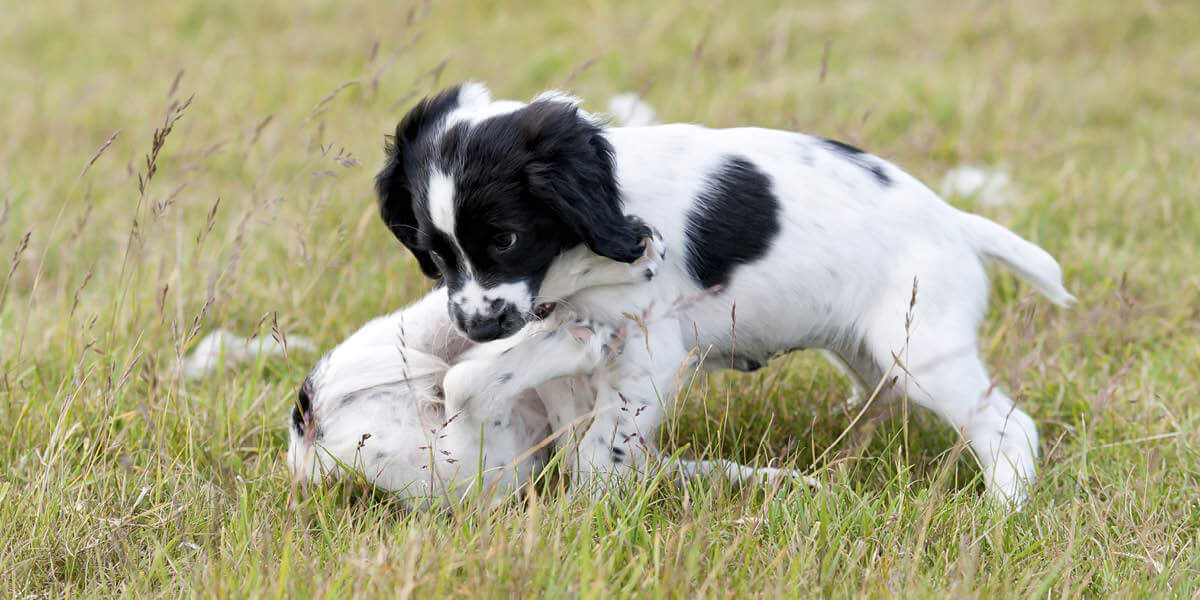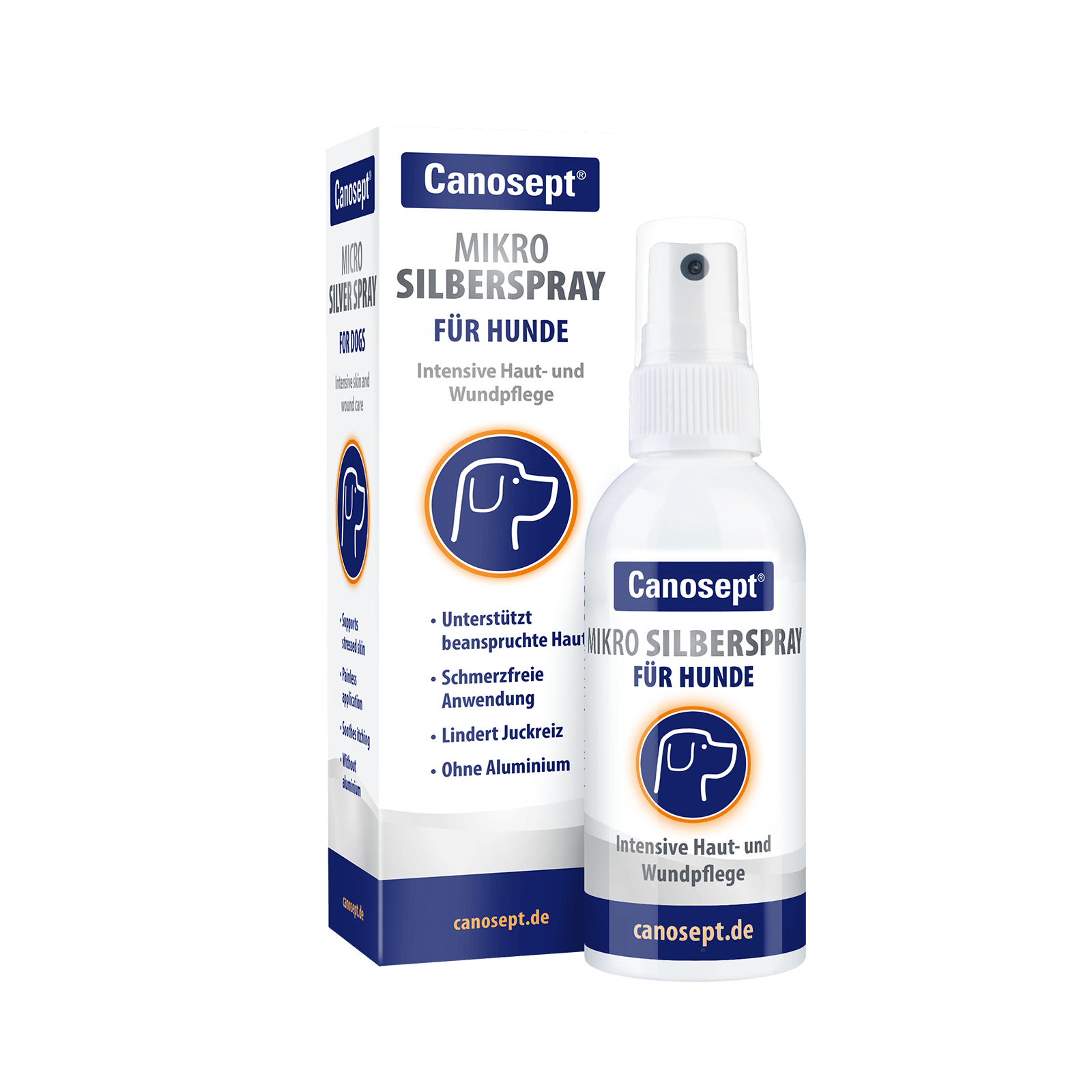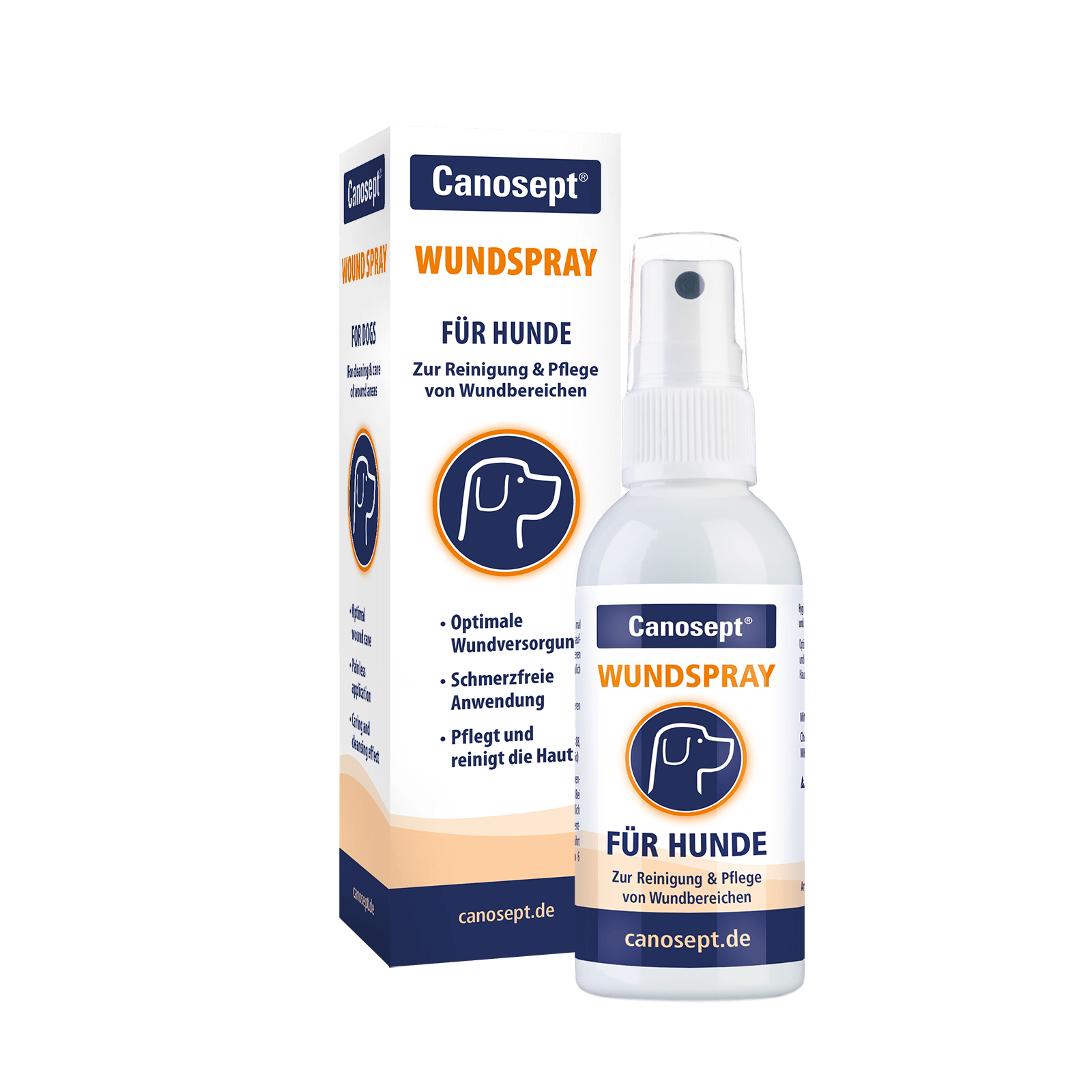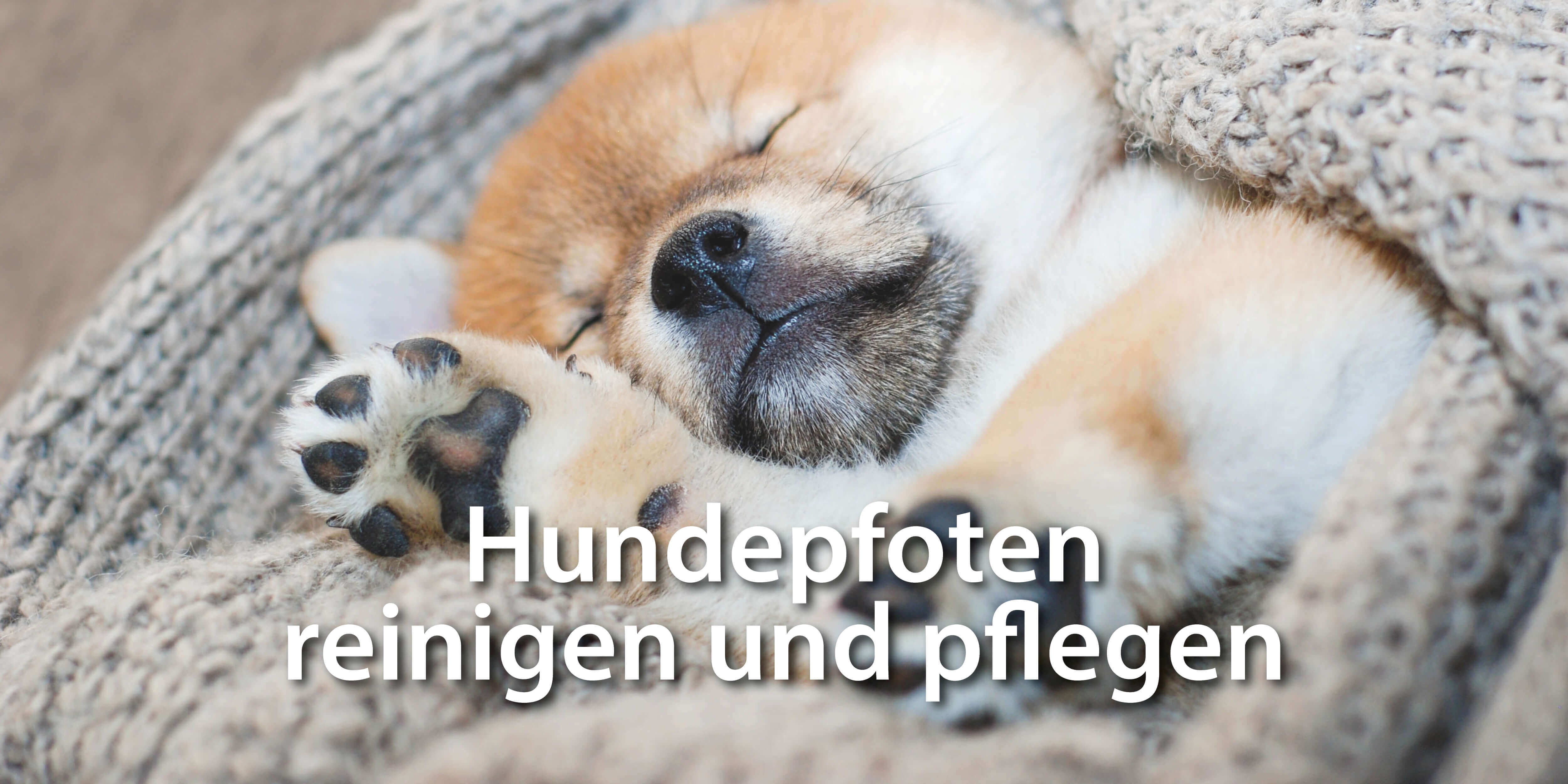- How do wounds occur?
- How do I recognize a wound on my dog?
- Can I treat the wound myself
- First aid measures
- Dog wound care – what you can do
- What do I need for wound care in my dog?
- How does wound care work at the vet?
- Why is my dog licking the wound?
- The most important things at a glance
How do wounds occur in dogs?
In most cases, you'll be out with your dog and will be aware of a wound or injury. However, your dog can also injure itself in an unobserved moment.

While playing
Dogs, especially young dogs, love "biting games." These are generally harmless, even if the vocalizations often suggest otherwise.
However, if things get "too rough," injuries to the skin and mouth can occur. Even in dog daycare centers, mostly harmless skin injuries occasionally occur during play.
While walking
"He's not doing anything." "He just wants to play." "He's never done that before." Almost all dog parents have heard these sayings about strange dogs. However, biting can always occur, and skin injuries are often the result.
Self-inflicted injuries
Whether due to the high spirits of a puppy or young dog, or due to the decreasing mobility of older dogs, both can lead to injuries or wounds in your dog.
Foreign body
Foreign bodies can penetrate the skin and cause injuries. For example, stubble fields harvested in late summer and autumn can cause injuries to the paws, legs, and lower abdomen. Thorns (e.g., blackberries and thorn hedges) can also cause wounds in dogs, where the thorns puncture the skin or become embedded in the skin.
How do I recognize wounds?
With trained senses, dog parents can recognize individual changes (e.g. swelling/sensitivity to pain) early on and act accordingly.
- Visual: Observe your dog. Does your dog lick or bite certain areas of his fur? Do you notice any wet patches?
- Feel: If you have felt an injury or wound, check the skin for further wounds by gently stroking the fur.
- Hearing: You can also detect injuries with your ears, as many dogs make sounds when they express pain.
- Smell: Some wounds can also be detected with the nose. If you miss them, they can become infected with bacteria. These smell differently or even unpleasantly.

Can I treat my dog's wound myself?
If you've discovered a wound on your dog, the first thing to do is stay calm. To determine whether you can treat the wound yourself or need to see a vet, you can ask yourself two questions:
- How deep and large is the wound?
- What kind of wound is it?
How deep and large is the wound?
The depth and size of your dog's skin injury can indicate whether you can treat the wound yourself.
Depth of the skin wound
All dog parents who have experienced injuries themselves know that the depth of the wound determines the next steps. If the injury is superficial to the skin, wound care is required. This includes cleaning, stopping the bleeding, and covering the wound if necessary.
Deep, gaping wounds in which the connective tissue (light/white) and possibly also the muscles (red) become visible are a case for first aid measures.
After that, wound care should be immediately taken care of by your veterinarian.
Size of skin injuries
Skin injuries that are superficial and smaller than approximately 2 cm can be treated at home. Any wounds larger than this should be treated at a veterinary practice after initial treatment, cleaning, and dressing.
What kind of wound is it in the dog?
Just like with humans, there are not only differences in the size and depth of the wound, but there are also different types of wounds in dogs.
Fur and skin
Your dog's coat protects and prevents skin injuries very effectively. The downside is that we can't see wounds directly, especially in long-haired and wire-haired dog breeds. Skin injuries can only be detected by examining the coat.
Skin incision, skin tear
Sharp objects often cause deep wounds in dogs. If a blood vessel is struck, severe bleeding can occur. A "skin slash" wound affects only the outer layers of skin, making it a superficial wound.

Skin abrasions
Due to the dog's coat, abrasions are rare, but they do occur. Such wounds usually occur in areas with little fur, such as the lower abdomen.
What does a graze on a dog look like?
Abrasions are superficial wounds in which hair is broken off and the outer (keratinized) epithelium of the skin is extensively damaged. Abrasions in dogs, as in humans, are often oozing wounds. These skin injuries are superficial and usually heal without scarring.
Bruises, swelling
Injuries can occur even without external skin wounds. For example, during romping and playing, violently hitting objects, trees, etc. While the skin remains unharmed, a bruise (bruise) may develop under the skin.
These are often very painful, and the dog won't allow you to touch them. In such cases, you should consult your veterinarian to determine whether it's just a minor bruise or whether muscles, ligaments, or even bones are affected.

First aid measures
- Test your dog's pupil and eyelid reflex
- Check the cardiovascular situation
- Position the injured body areas softly and stably
- Clean the wound, e.g. with Canosept wound spray
- Cover the wound if necessary
How do I disinfect my dog's wound?
Heavily contaminated wounds can be rinsed with clean water. Canosept Wound Spray is then ideal for cleansing the wound. It also provides optimal support for wound care.
Which wound disinfectant for dogs?
Canosept Wound Spray is suitable for wound cleansing. If a dressing is necessary, Canosept Wound Gel not only cleanses the wound but also prevents it from sticking to bandages and plasters.

Dog wound care – what you can do
The options for wound care for your dog vary depending on the type of wound. We'll give you an overview.
- Small and superficial wounds
- Larger wounds
- Bleeding wounds
- Bite injury
- laceration
- stab wound
- Burns
- Removal of foreign bodies
- Paw injury
What supports wound healing in dogs?
Wound healing is best supported by prompt and tailored wound care. For almost every wound, the dog's parents should clean the wound and, if necessary, cover it.
Small and superficial wounds
You can treat small and superficial wounds yourself. Wound care for your dog involves cleaning and caring for the wound.
For this purpose, you can use Canosept Wound Spray , which is simply sprayed onto the wound to cleanse and provide optimal wound care. You can also painlessly apply the colorless, odorless Canosept Wound Gel to the wound. It absorbs quickly and can be used under bandages and plasters without sticking.
Larger wounds
For initial treatment, you should keep the wound as clean as possible. The painless Canosept wound spray is ideal for this. This reliably removes dirt, dead cells, fat particles, and sebum residue, supporting optimal wound care. Further wound care for larger wounds should always be handled by your veterinarian.
For larger wounds, further wound care should always be carried out by your veterinarian.
Bleeding wounds
If your dog has an open, bleeding wound, the bleeding must first be stopped. If it's just a graze or a scrape, it's often enough to simply apply a sterile wound dressing to the area until the bleeding stops. Your dog should be kept calm.
Then begin cleaning the wound, for example, with Canosept Wound Spray . It may be necessary to trim the dog's fur around the injury to prevent it from sticking to the wound.

Heavy bleeding
If the wound is deeper, such as a cut, a pressure bandage may also be necessary. This should only be applied in an acute emergency to stop the bleeding (source: VDH). Due to the resulting reduced blood flow, the pressure bandage should not remain on the wound for too long.
Here's how to proceed:
- Cover the wound with a sterile compress.
- Press a wrapped, rolled-up gauze bandage firmly onto the compress.
- Secure the rolled-up gauze bandage with a second one. It's important to apply pressure to the wound.
- See a veterinarian as soon as possible.
What helps with open wounds in dogs?
For open or bleeding wounds, the bleeding must first be stopped. For this, you will need sterile compresses. In cases of severe bleeding, a pressure bandage should be applied as an acute emergency measure.
Remove foreign bodies
Foreign bodies are usually best removed with tweezers. When removing foreign bodies, it's important that you feel comfortable using tweezers and your dog is already accustomed to them. Use the tweezers in a way that avoids injury.
You can remove superficial foreign bodies, such as thorns, yourself. Foreign bodies that have penetrated deeper into the skin should be removed by a veterinarian.
Furthermore, size is crucial. Large foreign bodies, such as a piece of broken glass, should be removed by a veterinarian. The risk of severe bleeding or other complications is too great if removed on your own.
Bite injury
Regardless of whether your dog was bitten by a cat or another dog, a bite wound should be treated by a veterinarian. Even if the wound is small, germs can enter the dog through the teeth and saliva. These can cause infections. Furthermore, it's often unclear whether and to what extent the tissue beneath the skin's surface is damaged. (Source: Veterinary Medicine Portal)
laceration
Where the skin lies unpadded on the bone, lacerations can occur as a result of a blow. Since lacerations often require stitches, the wound should be seen by a veterinarian as soon as possible.
Lacerations can only be easily sutured by a veterinarian within six hours. The stitches are then removed after about 10 days. Unless the practice uses self-dissolving stitches, the part of the stitch that lies beneath the skin is broken down by the body, and the outer part simply falls off on its own.
stab wound
Puncture wounds include wounds caused by thorns, wood splinters, or insect bites. Infectious pathogens can easily penetrate and multiply in these small wounds. Check to see if you need to remove any foreign bodies. Then clean the wound, e.g., with Canosept wound spray .
Burns
To avoid skin damage, cool burns as quickly as possible with cold water or a cold pack. Discuss the severity of the burn and the next steps with your veterinarian.

Paw injury
During regular paw checks, dog owners can identify dry, possibly cracked paws and apply moisturizing Canosept Paw Care early on. If superficial wounds do occur, Canosept Wound Spray or Canosept Wound Gel can be used for optimal wound care.
The first aid kit for emergencies: What do I need to care for my dog’s wounds?
If you want to be prepared for an emergency, there are a few things you should have in your first aid kit for optimal wound care for your dog.
- Rounded scissors for trimming fur
- Product for disinfection or cleaning, e.g. Canosept wound spray or Canosept wound gel
- Sterile compresses
- Gauze bandages
- tweezers
- Cooling pads

Veterinary treatment
In practice, there are significantly more options for thorough wound treatment. The wound is first rinsed and disinfected. The veterinarian also removes any foreign bodies and assesses the extent of the damage. While these wounds may appear unspectacular from the outside, they can be more dangerous than you might think due to deeper injuries or a high risk of infection.
The veterinarian and their medical staff will treat the wound to promote proper healing and prevent scarring, and will close it with staples, for example. They will then inform you about further steps and the appropriate medication. If your dog's wound needs to be treated under anesthesia, this can only be done by a veterinarian.
My dog licks the wound
Almost all dog parents are familiar with the urge to lick wounds. This is your dog's attempt to relieve the itching, which is caused by various substances released during the wound healing process.
Licking the wound can cause it to open further and not heal properly. Therefore, it may be helpful to cover the wound.
In some cases, wearing a neck brace is necessary. In all cases, it's important to monitor the wound healing and contact your veterinarian if you have any concerns.
The most important things at a glance
- Get an overview of the dog’s state of consciousness
- Cleaning and, if necessary, covering the wound are important first aid measures
- Superficial and small wounds can often be treated by dog parents themselves, e.g. with a wound spray or wound gel for dogs
- Deep and large wounds are a case for the veterinarian
- The correct wound care for dogs depends on the type of wound
- Wound healing should always be monitored. If there are any delays or uncertainties, consult your veterinarian immediately.









